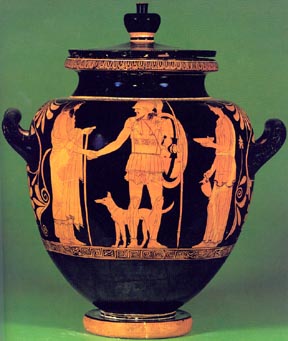
ARTH232  SPRING 2016 SPRING 2016  SCHEDULE SCHEDULE  REQUIREMENTS REQUIREMENTS
High Classical
c. 450-400 BCE
POTTERY

Achilles Painter
Warrior taking his leave
c. 450 BCE
(British Museum, London)
The warrior, a hoplite armed for war, shakes the hand of his aged father as he prepares to leave for battle. His wife on the right holds a phiale (a shallow bowl) and an oinochoe containing wine. After she has poured wine into the phiale, she will spill some on the ground as a libation to the gods and then each shall drink from it, in a last gesture of family unity.

White-ground Lekythos
Warrior at his Tomb
c. 410 BCE
approx. 19 inches high
(Archaeological Museum, Athens)
Later in the fifth century, a third style is developed called white-ground. During the late fifth century BCE, white-ground lekythoi became popular as grave ornaments.
An example of white-ground lekythos shows a warrior sitting wearily on the base of the stele of his own tomb. He uses two upright spears held in his left hand to support himself. A woman (not visible in this illustration) and a young man stand on either side. His expression is melancholy and touching. He is rendered as if seated in a three-dimensional space — his body moves naturally, bending slightly at the waist, and his head inclines. The drapery falls over his legs as it would in reality, and his left thigh and shield are foreshortened. There is a remarkable freedom in the brushwork. Lines are brushed in as in a sketch, and colours are lightly washed across the surface. Greek interest in naturalism is reflected in numerous accounts of artists' ability to create illusionistic images. By the second half of the fifth century, painters such as Zeuxis were painting from live models and therefore directly from nature.

Meidias Painter (attrib.)
TOP: Rape of the Daughers of Leucippus
BOTTOM: Herakles in the Garden of the Hesperides
c. 410-400 BCE
Height 201/2"
(British Museum, London)
|
|
|
|
© Christopher L. C. E. Witcombe
|

 SPRING 2016
SPRING 2016  SCHEDULE
SCHEDULE  REQUIREMENTS
REQUIREMENTS

 SPRING 2016
SPRING 2016  SCHEDULE
SCHEDULE  REQUIREMENTS
REQUIREMENTS